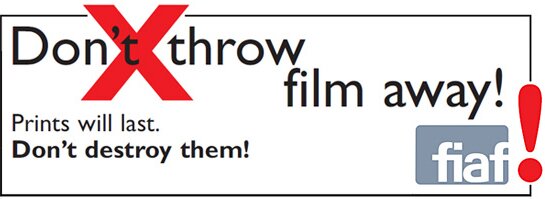|
The Chinese Taipei Film Archive (CTFA) joined FIAF in 1995. International Federation of Film Archives (FIAF) is an organization to promote the preservation of film and film-related materials, to develop co-operation between its affiliates, and to promote film art and culture. After CTFA became a full member, we have established friendship and exchange experiences on film preservation, restoration, digital archiving and film screenings, etc. with FIAF members worldwide. In November, 2006, CTFA has hosted FIAF Executive Committee meeting in Taipei. President Eva Orbanz has presented 2006 FIAF Award to Director Hou Hsiao Hsien to congratulate his contribution in film preservation.
To fulfill one of our missions, to promote Taiwan cinema, CTFA has loaned prints to many international film festivals. Another contribution is to provide prints of Taiwan films screenings overseas organized by our parent body, Government Information Office, Executive Yuan.
To introduce new technology, CTFA has organized “International Symposium and Short Term Training of Preservation and Restoration” in November, 2006 and “Digital Restoration Symposium” in July, 2009, over 20 experts and professionals were invited from FIAF members and non FIAF members.
When FIAF celebrated its 70 anniversary, a manifesto was presented. This manifesto advocates the importance of “Don’t Throw Film Away,” and emphasized once again the importance of film preservation. Here we post it as following:

Don’t Throw Film Away - The FIAF 70th Anniversary Manifesto
Motion picture film forms an indispensable part of our cultural heritage and a unique record of our history and our daily lives. Film archives, both public and private, are the organizations responsible for acquiring, safeguarding, documenting and making films available to current and future generations for study and pleasure.
The International Federation of Film Archives (FIAF) and its affiliates comprising more than 130 archives in over 65 countries have rescued over two million films in the last seventy years. However for some genres, geographical regions and periods of film history the survival rate is known to be considerably less than 10% of the titles produced.
On the occasion of its 70th anniversary, FIAF offers the world a new slogan: “DON’T THROW FILM AWAY”. If you are not sufficiently equipped to keep film yourself, then FIAF and its members will gladly help you locate an archive that is. Film is culturally irreplaceable, and can last a long time, especially in expert hands.
While fully recognizing that moving image technology is currently driven by the progress achieved in the digital field, the members of FIAF are determined to continue to acquire film and preserve it as film. This strategy is complementary to the development of efficient methods for the preservation of the digital-born heritage. FIAF affiliates urge all those who make and look after films, whether they be professionals or amateurs, and the government officials in all nations responsible for safeguarding the world cinema heritage, to help pursue this mission.
The slogan “DON’T THROW FILM AWAY” means that film must not be discarded, even though those who hold it may think they have adequately secured the content by transferring it onto a more stable film carrier or by scanning it into the digital domain at a resolution which apparently does not entail any significant loss of data. Film archives and museums are committed to preserve film on film because:
• A film is either created under the direct supervision of a filmmaker or is the record of an historical moment captured by a cameraman. Both types are potentially important artifacts and part of the world’s cultural heritage. Film is a tangible and “human-eye readable” entity which needs to be treated with great care, like other museum or historic objects.
• Although film can be physically and chemically fragile, it is a stable material that can survive for centuries, as long as it is stored and cared for appropriately. Its life expectancy has already proved much longer than moving image carriers like videotape that were developed after film. Digital information has value only if it can be interpreted, and digital information carriers are also vulnerable to physical andchemical deterioration while the hardware and software needed for interpretation are liable to obsolescence.
• Film is currently the optimal archival storage medium for moving images. It is one of the most standardized and international products available and it remains a medium with high resolution potential. The data it contains does not need regular migration nor does its operating system require frequent updating.
• The film elements held in archive vaults are the original materials from which all copies are derived. One can determine from them whether a copy is complete or not. The more digital technology is developed, the easier it will be to change or even arbitrarily alter content. Unjustified alteration or unfair distortion, however, can always be detected by comparison with the original film provided it has been properly stored.
Never throw film away, even after you think something better comes along. No matter what technologies emerge for moving images in the future, existing film copies connect us to the achievements and certainties of the past. FILM PRINTS WILL LAST - DON’T THROW FILM AWAY.
April 2008, Paris (revised July/September, 2008)
|